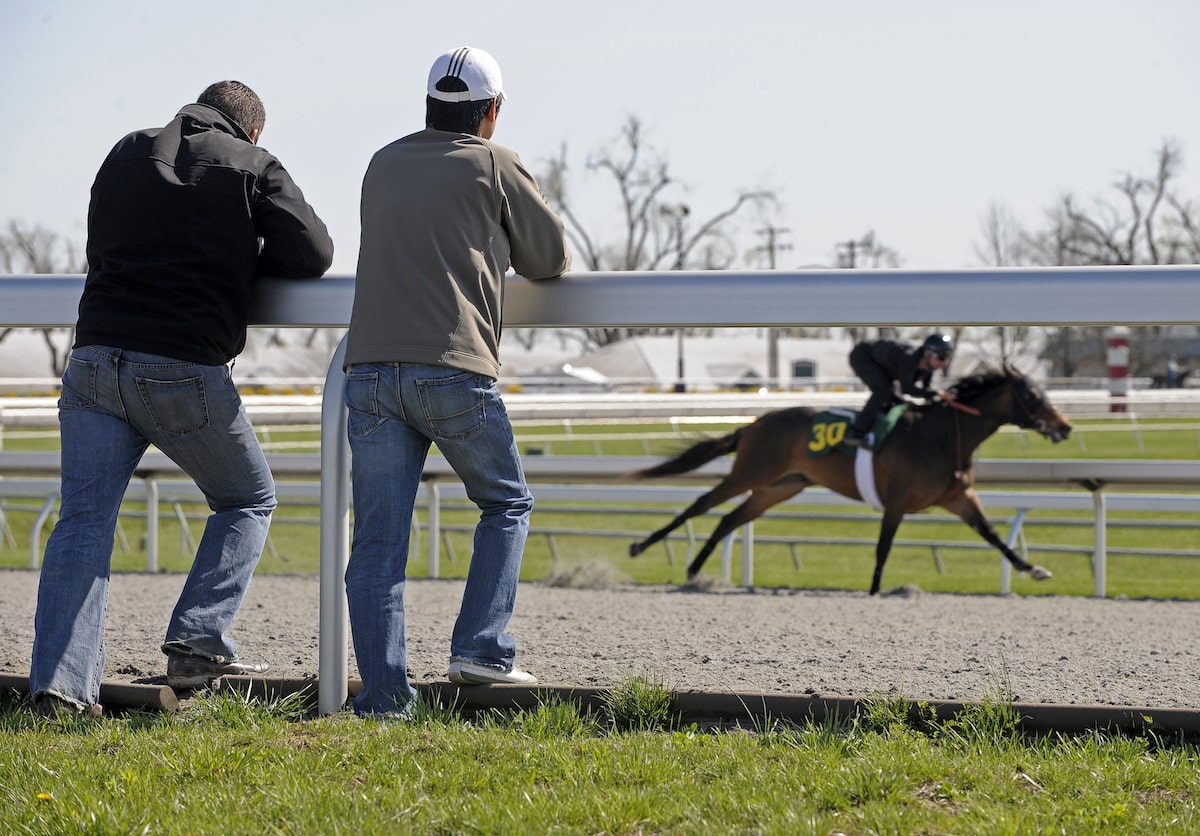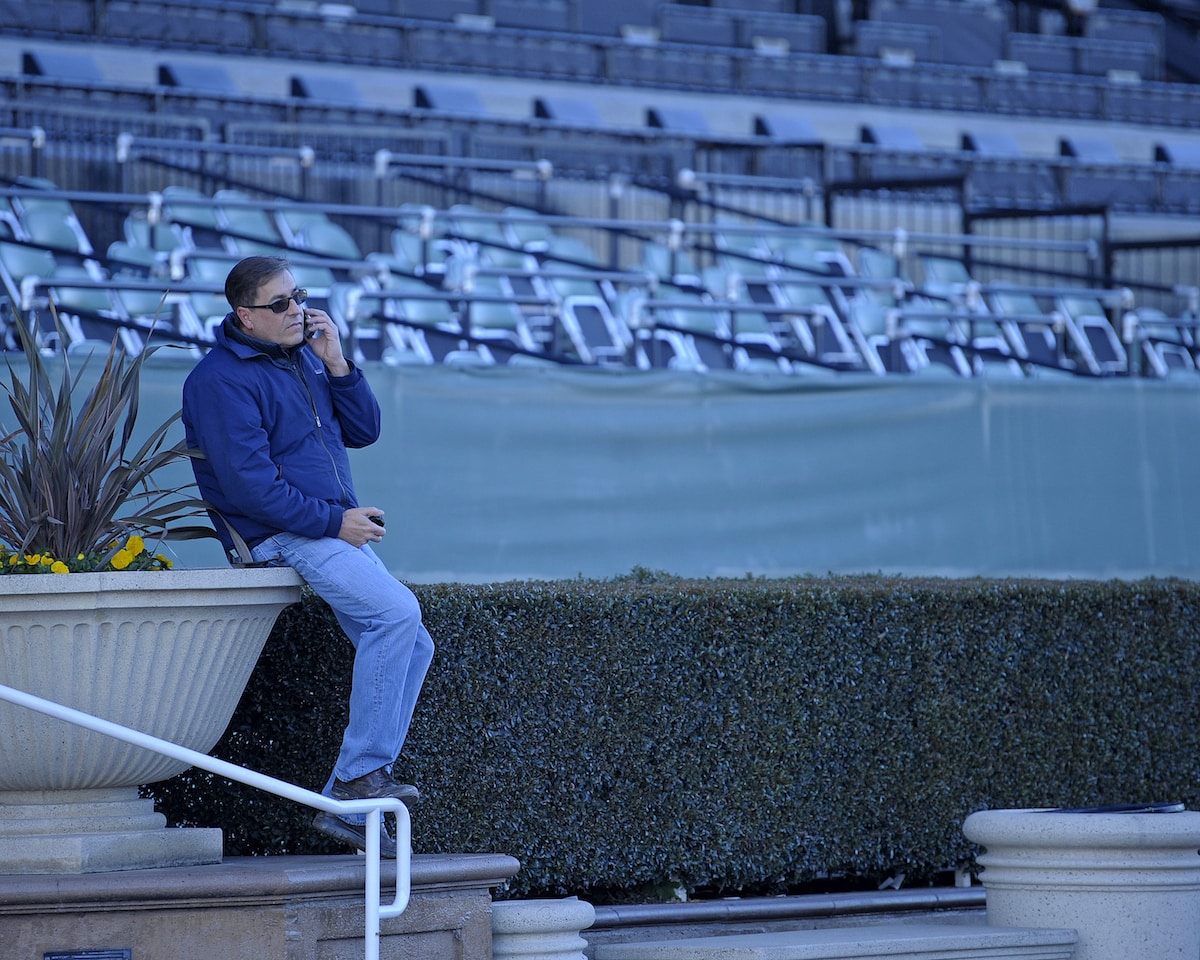Head to the track at daybreak to see the horses work at varying speeds and distances

A “breeze” in race training is akin to a wind sprint in track and field. Courtesy Anne Eberhardt/The Horse Staff
If you’ve only attended the racetrack in the afternoons, you could be missing the best part of horse racing. Sure, watching horses strive for the finish line, especially when the horse you bet on reaches it first, engenders excitement. But for the pure horse enthusiast, watching morning workouts can prove even more enjoyable.
Many racetracks allow fans to watch the morning workouts, and it doesn’t cost a thing. In the days leading up to big events such as the Kentucky Derby or the Breeders’ Cup, it’s a way for people to see the stars — American Pharoah, Nyquist, Beholder.
If you go, you’ll see horses doing everything from jogging and galloping to moving at what appears to be racing speed. Just what is going on and what are trainers trying to accomplish when they “work” or “breeze” a horse?
Learning the Ropes
John Sadler, who began his equine career riding hunters and jumpers — at one point participating in U.S. screening trials for the Olympic team — oversees a large stable of racehorses based in Southern California. He has trained winners of more than $100 million during his career, and his current barn includes Stellar Wind, the 2015 U.S. champion 3-year-old filly. He has also been a vocal proponent for finding second careers for horses after their racing days have ended.
“When we’re getting horses ready to run, we work them at what we call three-quarter speed,” says Sadler. “It’s about three-quarter speed of what we’ll ask them to run in a race. Galloping would be about half speed.”
As with any equine sport, horses cannot jump right into this kind of activity. Before a young horse even arrives at a trainer’s barn, he has learned lessons that range from adjusting to the standard saddle, bit and rider to galloping on a training track, usually at a farm.
Some farms pony the horses first with older horses outriders use to accompany racehorses at the track. This involves taking the younger horse out to gallop alongside without rider or saddle. Eventually, young horses with a rider aboard will go to the track on their own.
“They probably have at least 90 days of galloping before they come here,” says Sadler.
Racehorses begin their careers early, especially compared to other disciplines such as jumping and dressage. Trainers often get their 2-year-olds in during the spring, and depending on each horse’s progress, the youngsters could begin competing in late spring, summer or fall. Not every horse will race at 2, and part of a trainer’s job is to assess the optimum time for a horse to start its career.
A workout pattern can reveal where each horse stands in physical fitness, ability to race at speed and — perhaps most importantly — mental fitness.
Sadler compares the process to training a show jumper.
“You don’t take them over a big fence right away,” he says. “You start with riding in a ring and working with them.” A horse will usually train over ground poles and then small jumps before ever attempting anything of size.
It’s the same with a racehorse. A 2-year-old new to the racetrack might simply walk around the barn at first, led by a groom. Some trainers might pony a horse to get him used to a racetrack. Next comes jogging, usually done on the outside rail of the track going clockwise as a safety precaution so joggers will see horses galloping the other direction.

Trainer John Sadler oversees a large racing stable in Southern California. He monitors his horses’ morning workouts and adjusts each horse’s schedule as that individual requires. Courtesy Anne Eberhardt/The Horse Staff
Establishing a Routine
American racing is conducted counterclockwise, which might have resulted from Colonial days when oval racetracks were purposely run the opposite direction of England’s clockwise racetracks. Thus, all U.S. racehorses train at galloping speed or faster only counterclockwise.
Horses gallop a mile or two daily, depending on their fitness level and what the trainer deems advisable. Again for safety, gallopers will take the center of the track, leaving the inside rail free for horses working at speed.
Working at speed, termed a “work” or a “breeze,” is done at shorter distances on the inside rail. It’s akin to what a track and field coach might call wind sprints.
“We work them about every six or seven days at a short distance,” says Sadler. “We increase the distance until they’re up to being ready to run.”
Sadler explains that a typical work pattern could involve several works at three furlongs (a furlong being equal to an eighth of a mile), then several more works at four and five furlongs. A horse might only need two workouts at six furlongs before being ready to run, most horses begin their racing careers in a six-furlong race.
“Usually we give a horse a day off after a work,” says Sadler. “We work, we walk a day, we jog a day, we gallop three days, and then work again.”
That regimen is just a starting point, however, as trainers adjust each horse’s schedule as that individual requires. A horse’s legs need time to recover from the stress of a work — a veterinarian might explain it as the bone needing time to remodel and strengthen. Trainers check a horse’s legs every day to make sure they are sound and ready for whatever the training schedule requires.
Heat in the lower leg often indicates a problem. In those cases, Sadler adjusts the horse’s schedule.
“You address the problem,” he says. “Does it need an X-ray or just some time off? There is every kind of scenario.”
As with trainers in other disciplines, racehorse trainers employ a variety of therapies to keep their horses feeling good. Cold therapy — icing or hosing — works in some cases, as do things like chiropractic and massage. If the problem is severe enough, the horse might need time at a farm or layup facility, perhaps for pasture turnout or stall rest.
Interpreting a Work
Because people wager money on racehorses, workout times and distances are made available to the public. You can find each day’s workouts on the racetrack’s website, at equibase.com or in the Daily Racing Form. A black dot, or a bullet, beside a horse’s name denotes that it was the fastest work of the day at that distance, known as a “bullet work.”
The speed at which a horse works might demonstrate how fast he is, but not always. Trainers sometimes tell the exercise rider or jockey exactly how fast to go. The weight of the rider could impact the time, and because jockeys are usually lighter than exercise riders, some trainers use jockeys for speed works.
The trainer pays close attention to how the horse completes the work.
“With two identical works in the same time, one could be good and one could be bad just by how easily one is accomplished,” says Sadler. “Do they go fast and slow down? Do they go slow early and finish fast?”
Sometimes a horse works better in company with another horse. This might teach a young horse about competition, or it might keep an older horse from being lazy in the morning.
A top horse could even benefit from a game of chase. A trainer might instruct one rider to start the work before the other horse, giving the second horse an opportunity to go after the first horse and catch him.
It’s all part of the art of training, something you can witness for yourself. That might require rising early — training hours typically run from 5-9 a.m. But it’s worth it to see these magnificent Thoroughbreds get ready to race.
This article was originally published in the Summer 2016 issue of Off-Track Thoroughbred Magazine, the only publication dedicated to the Thoroughbred ex-racehorse in second careers. Want four information-packed issues a year delivered to your door or your favorite digital device? Subscribe now!

